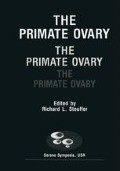Summary
The ovarian cycle of the common marmoset (Callithrix jacchus) is intermediate with those of laboratory rats and human beings. There are also qualitative and quantitative similarities between preovulatory granulosa cell function in marmosets and women. Cyclic and acyclic (reproductively suppressed) marmoset ovaries are packed with multiple immature follicles, and these contain granulosa cells which respond biochemically and morphologically to human FSH in vitro. Hormonedependent differentiation can, therefore, be studied systematically using primary cell cultures, the strategy which has contributed so much to current concepts of nonprimate folliculogenesis. Our experience establishes the marmoset monkey as a valid laboratory model for studies of cellular aspects of folliculogenesis in primates.
Access this chapter
Tax calculation will be finalised at checkout
Purchases are for personal use only
Preview
Unable to display preview. Download preview PDF.
References
Channing CP, Thanki K, Lindsey AM, Ledwitz-Rigby F. Development and hormonal regulation of gonadotrophin responsiveness in granulosa cells of the mammalian ovary. In: Birnbaumer L, O’Malley BW, eds. Receptors and hormone action. New York: Academic Press, 1978:435–55.
Richards JS. Maturation of ovarian follicles: actions and interactions of pituitary and ovarian hormones on follicular differentiation. Physiol Rev 1980; 60:51–89.
Hsueh AJW, Adashi EJ, Jones PBC, Welsh TJ Jr. Hormonal regulation of the differentiation of cultured ovarian granulosa cells. Endocr Rev 1984; 5:76–127.
Dorrington JH, McKeracher HL, Chan AK, Gore-Langton RE. Hormonal interactions in the control of granulosa cell differentiation. J Steroid Biochem 1983; 19:17–32.
Hillier SG. Sex steroid metabolism and follicular development in the ovary. In: Clarke JR, ed. Oxford reviews of reproductive biology; vol 7. Oxford: Clarendon Press, 1985:167–222.
Hearn JP. Marmosets and tamarins. In: Poole T, ed. The UFAW handbook on “The care and management of laboratory animals.” 6th ed. Harlow: Longman Scientific & Technical, 1987:568–81.
Eastman SAK, Makawiti DW, Collins WP, Hodges JK. Pattern of excretion of urinary steroid metabolites during the ovarian cycle and pregnancy in the marmoset monkey. J Endocrinol 1984; 102:19–26.
Harlow CR, Hearn JP, Hodges JK. Ovulation in the marmoset monkey: endocrinology, prediction and detection. J Endocrinol 1984; 103:17–24.
Harlow CR, Gems S, Hodges JK, Hearn JP. The relationship between plasma progesterone and the timing of ovulation and early embryonic development in the marmoset monkey (Callithrix jacchus). J Zool Lond 1983; 201:273–82.
Summers PM, Wennink CJ, Hodges JK. Cloprostenol-induced luteolysis in the marmoset monkey, Callithrix jacchus. J Reprod Fertil 1985; 73:133–8.
Harlow CR, Shaw HJ, Hillier SG, Hodges JK. Factors influencing FSH-induced steroidogenesis in marmoset granulosa cells: effects of androgens and stage of follicular development. Endocrinology (submitted).
Abbott DH. Behavioral and physiological suppression of fertility in subordinate marmoset monkeys. Am J Primatol 1984; 6:169–86.
Harlow CR, Hillier SG, Hodges JK. Androgen modulation of folliclestimulating hormone-induced granulosa cell steroidogenesis in the primate ovary. Endocrinology 1986; 119:1403–5.
Hillier SG, Reichert LE Jr, van Hall EV. Control of preovulatory follicular estrogen biosynthesis in the human ovary. J Clin Endocrinol Metab 1981; 52:847–56.
Hillier SG, Knazek RA, Ross GT. Androgenic stimulation of progesterone production by granulosa cells from preantral follicles: further in vitro studies using replicate cell cultures. Endocrinology 1977; 100:1539–49.
Erickson GF. Primary cultures of ovarian cells in serum-free medium as models of hormone-dependent differentiation. Mol Cell Endocrinol 1983; 29:21–49.
Hillier SG, de Zwart FA. Androgen/antiandrogen modulation of cyclic AMP-induced steroidogenesis during granulosa cell differentiation in tissue culture. Mol Cell Endocrinol 1982; 28:347–61.
Hsueh AJW. Paracrine mechanisms involved in granulosa cell differentiation. In: Franchimont F, ed. Clinics in endocrinology and metabolism; vol 15. London: WB Saunders, 1986:117–33.
Zeleznik AJ, Kubik CJ. Ovarian responses in macaques to pulsatile induction of follicle-stimulating hormone (FSH) and luteinizing hormone: increased sensitivity of the maturing follicle to FSH. Endocrinology 1986; 119:2025–32.
Zeleznik AJ, Schuler HM, Reichert LE Jr. Gonadotropin-binding sites in the rhesus monkey ovary: role of the vasculature in the selective distribution of human chorionic gonadotropin to the preovulatory follicle. Endocrinology 1981; 109:356–62.
Zeleznik AJ, Midgley AR Jr, Reichert LE Jr. Granulosa cell maturation in the rat; increased binding of human chorionic gonadotropin following treatment with follicle-stimulating hormone in vivo. Endocrinology 1974; 95:818–25.
McNatty KP, Hillier SG, van den Boogaard AJM, Trimbos-Kemper TCM, Reichert LE Jr, van Hall EV. Follicular development during the luteal phase of the human menstrual cycle. J Clin Endocrinol Metab 1983; 56:1022–31.
Author information
Authors and Affiliations
Editor information
Editors and Affiliations
Rights and permissions
Copyright information
© 1987 Plenum Press, New York
About this chapter
Cite this chapter
Hillier, S.G., Harlow, C.R., Shaw, H.J., Wickings, E.J., Dixson, A.F., Hodges, J.K. (1987). Granulosa Cell Differentiation in Primate Ovaries: The Marmoset Monkey (Callithrix Jacchus) as a Laboratory Model. In: Stouffer, R.L. (eds) The Primate Ovary. Serono Symposia, USA. Springer, Boston, MA. https://doi.org/10.1007/978-1-4615-9513-7_5
Download citation
DOI: https://doi.org/10.1007/978-1-4615-9513-7_5
Publisher Name: Springer, Boston, MA
Print ISBN: 978-1-4615-9515-1
Online ISBN: 978-1-4615-9513-7
eBook Packages: Springer Book Archive

